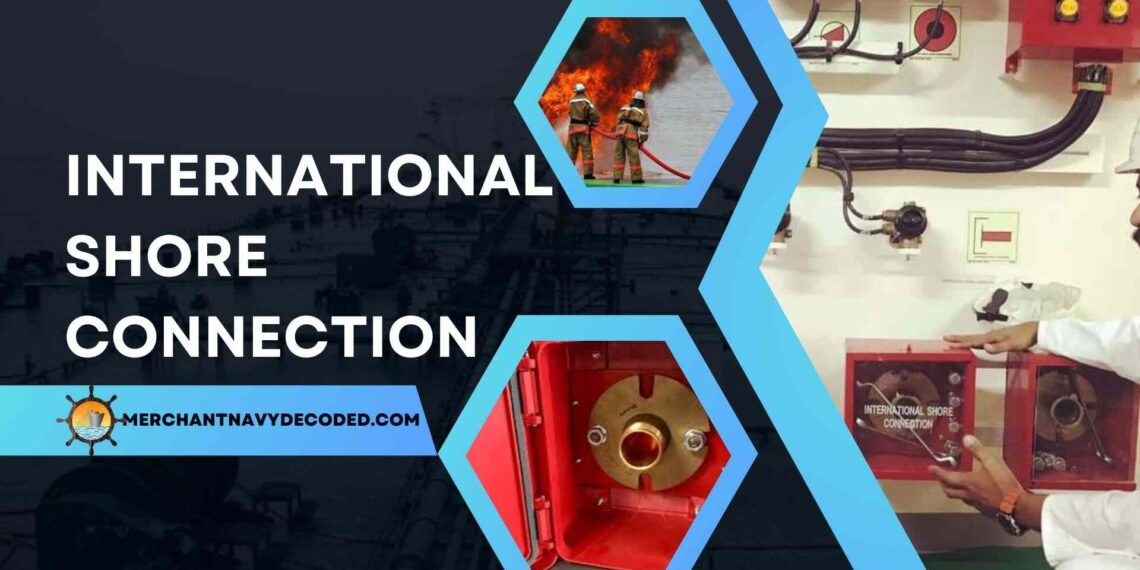What is the International Shore Connection on Ships?
1:- Overview of Internation Shore Connection
Fire Fighting onboard merchant ships is a difficult and crucial task. The ship is equipped with its own set of fire pumps to tackle the fire. What if it is just not enough? What if the primary as well as the emergency fire pumps fail? The International Shore connection deals with this very specific problem. It is a very important aspect of fire safety onboard ships and hence every seafarer must know in detail about it.
2:- What is the International Shore Connection and its Purpose?
The International Shore Connection/Coupling is a globally standardized connection flange fitted onboard, primarily used for fire-fighting. It allows the ship to take in water supply from the shore or another ship in case of an emergency.
3:- Why is International Shore Connection Needed
The universal and standardized nature of the coupling makes it ready to use and accessible to other support parties. This was the primary idea behind this coupling.
The International shore connection can be used in the following cases:
- Failure of the ship’s Fire Pumps and Emergency Pumps.
- The Fire becomes too intense and the ship’s crew needs additional support.
- To fight a Fire Emergency in the port use the port’s fire hydrant system.
- When the ship encounters a fire emergency at sea, another ship may use the ISC to support fire-fighting
4:- International Shore Connection and Location
The International Shore Connection is generally easily accessible and convenient. The exact location of the International Shore Connection onboard is mentioned in the Ship’s Fire Control Plan. Generally, it is protected in a red box with the International National Connection symbol marked near the gangway or on both sides of the accommodation area.
Following is the International Shore Connection Symbol:
5:- International Shore Connection Parts
The International Shore Connection falls under the category of Fire Safety Systems on ships. The FSS Code outlines requirements for the International Shore Connection in terms of dimensions, materials to be used, and accessories. Specifically, chapter 2 of the FSS Code is concerned with the International Shore Connection
Let’s Understand them in detail:
- Standard Dimensions:
The following table provides the standard dimensions of the ISC:
| Description | Dimension |
| Outside Diameter | 178 mm |
| Inside Diameter | 64 mm |
| Bolt Circle Diameter | 132 mm |
| Slots in Flange | 4 holes, 19 mm in diameter spaced equidistantly on the Bolt circle diameter |
| Flange Thickness | 14.5 mm minimum |
| Bolts and nuts | 4, each of 16 mm in diameter, and 50 mm in length |
- Materials and Accessories
- The International Shore Connection shall be of steel or other equivalent material
- It shall be designed for a design pressure of 1N/mm2
- The Flange shall have a flat face on one side and the other side, it should be permanently attached to a coupling that will fit the ship’s hydrant and hose.
- The connection shall be kept aboard the ship together with a gasket made of a material suitable for 1N/mm2 services, together with 4 bolts and 4 nuts of 16 mm diameter and 8 washers
6:- International Shore Connection SOLAS Requirements
The International Convention on the Safety of Life at Sea states specific carriage requirements for ships. The International Shore Connection is required under the SOLAS (Safety of Life at Sea) convention, specifically under Chapter II-2, Regulation 10.2.1.7.1, which mandates that all ships over 500 gross tons must carry at least one International Shore Connection.
Regulation 10.2.1.7.2 states that ‘Facilities shall be available enabling such a connection to be used on either side of the ship.’
7:- Maintenance Requirements of the International Shore Connection
As per IMO Circular- MSC 1432: Revised guidelines for maintenance and inspection of Fire Protection Systems and Appliances, The International Shore Connection should be inspected quarterly. The primary goal is to verify that the International Shore Connection is always in serviceable condition.
The Inspection may involve the following:
- Checking the presence of International Shore Connection in the location specified in the ship’s fire plan.
- Checking the presence and condition of the spanner.
- The rubber gasket’s condition should be checked and replaced if damaged.
- All nuts, bolts, and 8 washers should be present and in good condition
- Checking the condition of the markings.
8:- International Shore Connection FAQs
As per SOLAS Requirements, all Vessels of 500 GT and above must carry at least one ISC. Bigger vessels may install more than one connection for better emergency response.
The International Shore Connection is stored in a box near the gangway or on both sides of the accommodation area for easy access to shore-based or ship-ship water supply.
The International Shore connection is made of corrosion-resistant material such as Brass, Bronze, or BMC Glass Fiber Polyester.
Yes, it can be used to connect two ships, and the water supply be used during fire-fighting.
The ISC flange typically has an outer diameter of 178 mm, an inner diameter of 64 mm, and a bolt circle diameter of 132 mm. It uses four bolts, each 16 mm in diameter and 50 mm long.
Disclaimer :- The opinions expressed in this article belong solely to the author and may not necessarily reflect those of Merchant Navy Decoded. We cannot guarantee the accuracy of the information provided and disclaim any responsibility for it. Data and visuals used are sourced from publicly available information and may not be authenticated by any regulatory body. Reviews and comments appearing on our blogs represent the opinions of individuals and do not necessarily reflect the views of Merchant Navy Decoded. We are not responsible for any loss or damage resulting from reliance on these reviews or comments.
Reproduction, copying, sharing, or use of the article or images in any form is strictly prohibited without prior permission from both the author and Merchant Navy Decoded.



